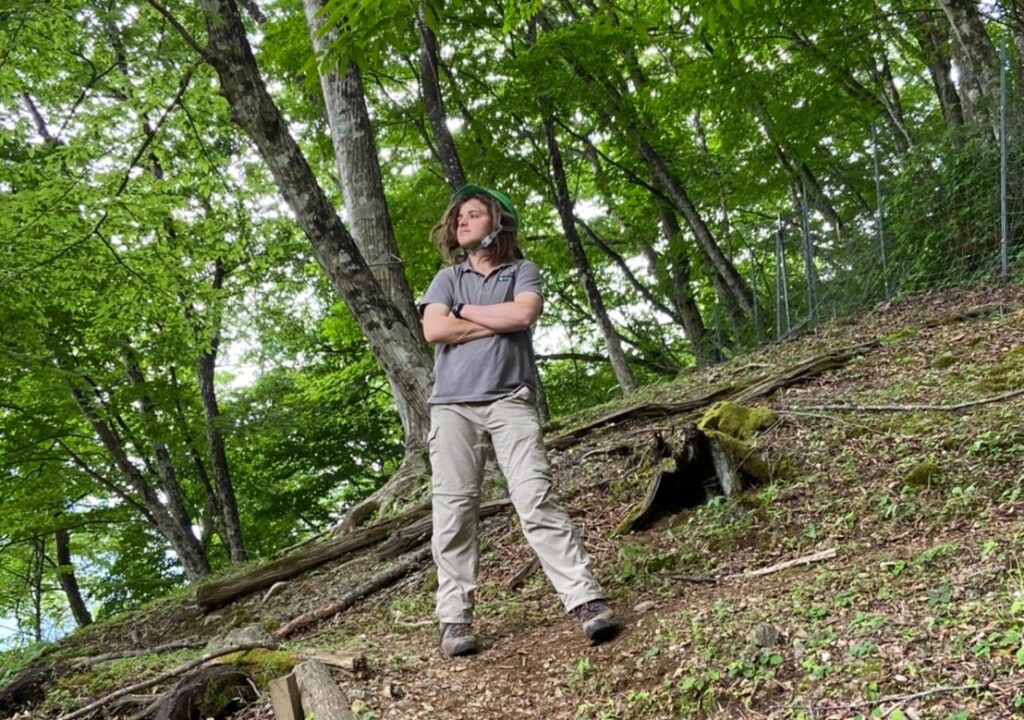Nationality: New Zealand
Period at AIU: Spring 2016
Occupation: Bear Conservationist
“We’ve got to keep our voices up, I’m pretty sure there’s bears around here!” It was a summer night in 2016, and me and my friend Greg from the US were walking through the woods back to AIU campus, after having left a student party to go catch frogs in a rice field. We were, naturally, covered in mud and completely delighted with ourselves for having found frogs in the middle of the night.
Such were the antics of a student life that could only be experienced in rural Akita.
Like many exchange students, I came to Japan with images of temples, pop culture and technology in my mind. What I didn’t know is Japan is covered in 70% forest and home to a beautiful natural heritage.
Being a lover of nature and raised in the countryside, I found Akita to be a place that reflected parts of myself and my hometown in New Zealand in ways I had never expected. It also turned out to be the place that led me on the path I’m on now.
In university, I double majored in English Literature and Ecology. After graduating, I worked as a Ranger in New Zealand managing the biodiversity of a national park, until my heart led me back to explore the countryside of Japan. Eventually I was offered a job in Nagano Prefecture as a nature guide and bear conservationist. Here, my job was to manage countermeasures against bears and to capture and release bears that came close to town back into the forest. The idea behind this is to protect bears and humans at the same time via a wildlife management technique called “aversive conditioning”. By using a loud combination of fireworks, human yelling, dog barking and rubber bullets while releasing the bear, these intelligent animals learn to be afraid of humans and to stay away from the area in which they were captured.
From April 2022, I will study my Master’s degree on the topic of bear attacks in Japan at Tokyo University of Agriculture.
My interest in this topic started in Akita. During my exchange in 2016, four people died in bear attacks in Akita, and bears were sighted near campus several times. I also took a class at AIU called Akita Rural Studies, which exposed me to the people of Akita’s disappearing villages. I feel that a large part of AIU’s philosophy is about connecting bridges; bridges between countries, bridges between people of different minds, and more. For me it opened up a world of connecting bridges between my hometown and Akita’s rural villages, and between humans and wild animals. I saw a lot of similarities between the local issues of my village in New Zealand and Akita’s countryside, such as lack of jobs, tourism and infrastructure. I also saw the issue of human and bear co-existence. In Japan, rural revitalization and human-wildlife conflict are directly related, and conflict with wildlife increases as the conditions of rural areas worsen. Being passionate about both these subjects and having gained hands-on experience in Nagano, I decided to study this topic further.
I’m hoping that my research can provide a guideline to governments and local people for how to manage and prevent bear encounters while promoting bear conservation. It’s a difficult goal because in recent years, conflict with wild animals has been increasing in Japan, and for so-called “dangerous” animals like bears, the immediate response has been to kill the bear. However bear populations are at increasing risk of extinction, and the world is facing a biodiversity crisis in which we need to conserve as many species as we can. On top of that, studies show that using countermeasures and “aversive conditioning” is actually more effective at reducing bear damage than killing bears. Picchio Wildlife Research Centre where I worked in Nagano has succeeded in reducing bear damage to 0-2 cases per year, while Akita continues to have one of the highest rates of bear damage in the country…
Unfortunately, many people don’t want to look at the science and their reasoning is to kill bears. However, I think that further research and education around bears can change this, just like in in parts of Nagano and the USA and Canada.
Although I haven’t been able to do this kind of work in Akita, I’m hoping that my research will bring me into contact with Akita’s bear problem, and one of my dreams is eventually to do this kind of work in Akita.

As a side job, I write articles about conservation and rural Japan and post wildlife photography to spread awareness. If you’re interested in sharing my journey or learning more, I would be grateful if you followed my Instagram, Facebook and checked out my website.
Regardless of being a domestic or exchange student, I think AIU has changed the lives of many of its alumni. For other alumni wanting to re-connect, if you resonated with anything I said, feel free to reach out. I’d especially like to hear from those who have ideas about how to foster a connection between people and nature in Akita.
To current students, my advice would be to step out of your comfort zone and try lots of different things. You may not be in a big city, but if you give yourself the chance to get involved in activities and experience rural life like a local, you can easily have experiences you could never have elsewhere.






コメント